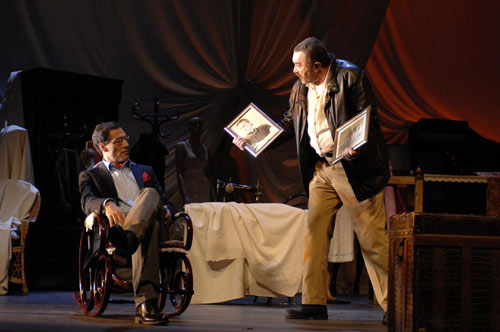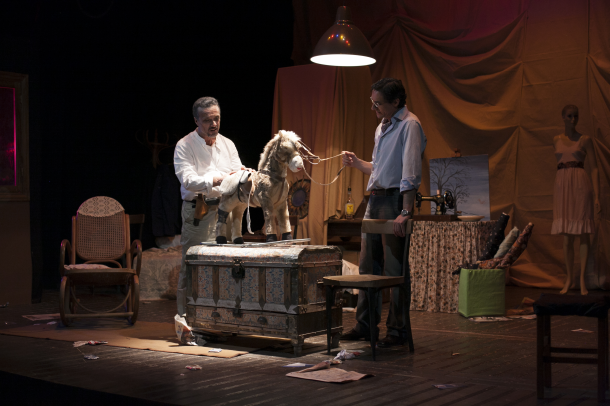At the time of writing, Spain’s principal gateway to the outside world is being expensively re-branded as the Adolfo Suárez-Madrid-Barajas Airport in honor of the recently-deceased ex-President, the first democratically-elected leader of the post-Franco period. This decision reveals the privileged place the Transition continues to perform in the collective imagination, while the controversy that has surrounded it—compounded by King Juan Carlos’s subsequent abdication—is symptomatic of the absence of a shared narrative for what occurred during the dictatorship and its immediate aftermath.
Transición (Transition), by Alfonso Plou and Julio Salvatierra, premiered by the Centro Dramático Nacional/National Dramatic Centre at the María Guerrero Theatre in Spring 2013. This meta-theatrical treatise on the personal and the political was written prior to these recent landmark events, but reflected the zeitgeist by which Spaniards are increasingly questioning the ostensible exemplarity of the passage from dictatorship to democracy. This state of affairs can be attributed to the current economic crisis alongside the debates that crystallized around the 2007 Law of Historical Memory, designed to acknowledge, but not compensate, the crimes committed against victims during both the Civil War (1936-39), and the nearly forty years of dictatorship that ensued (1939-1975). The legislation, introduced by José Luis Rodríguez Zapatero’s Socialist government (2004-2011), has been alternatively portrayed as an antidote to, or betrayal of, the so-called pacto de olvido (‘pact of forgetting’) or pacto de silencio (‘pact of silence’), the preferred remedy of political elites during the Transition to a consensual monarchical democracy. These underlying issues are addressed in a production that depicts a fictionalized television debate on the Transition; and, in a second but more dominant strand, the ruminations of a psychologically and physically infirm hospital patient, Adolfo, who may or may not be the former-President. The latter brings to mind similar scenes from The Iron Lady (Phillipa Lloyd, 2011), a film about Margaret Thatcher that I have always felt would have worked better as a stage-play. The cast of La Transición might not include anyone of the calibre of Meryl Streep, but the actors generally acquit themselves well, even if a rhetorical delivery, habitual in much Spanish theatre, can grate on occasion.
José Luis Alonso de Santos’ Trampa para pájaros (A Trick for Birds) features just three characters on stage and is particularly reliant on the performance of the actor cast as the chief protagonist, a policeman who struggles to come to terms with the fact that the violent authoritarian practices for which he was praised under the Franco regime are now subject to censure. This revival of a play originally written in the late 1980s and premiered in 1990 can be attributed to both the fashion for narratives of the Transition and the attractions of a small cast at a time of financial crisis. This crisis has been felt particularly acutely in the theatre world where an exponential decrease in the disposable income of spectators has been compounded by the increase in VAT leveled by the incoming conservative government presided by Mariano Rajoy (2011-). The lead actor and director Juan Luis Magallares’s tendency to communicate inner turmoil almost exclusively through verbal and physical agitation unfortunately eschews subtlety and nuance, while imbuing the production with an amateurish aesthetic that belies the nearly twenty-Euro ticket price. This is exacerbated by the exigencies of an attractive but costly to maintain medium-sized Italianate theatre which, presumably in a desire to optimize profits, frequently hosts two different productions a night, thereby necessitating a hastily assembled set with only cursory attention paid to lighting or sound design. The management of the Lara would have perhaps been better advised to have tried to recoup some money at the bar through the introduction of what would, at least for this spectator, have been a very welcome interval break.
One arguably positive consequence of the recession is the increased collaboration between National Theatres and private companies; the Centro Dramático Nacional collaborated on Transición with three independent companies (L’Om-Imprebís, Teatro Meridional and Teatro del Temple) in a project which, according to Julio Salvatierra’s introduction to the printed play-text, emerged from workshops, run at the beginning of 2011. What could be construed as a form of collective authorship is reflected onstage. Adolfo maintains conversations with figures such as Santiago Carrillo or King Juan Carlos, widely considered to be principal architects of the Transition; while the opening scenario of a present-infused television debate makes effective use of multi-media images by screening iconic clips from the period, ranging from Prime Minister Carlos Arias Navarro’s tearful address to the nation on the occasion of General Franco’s death to an infamous advert for Philips by actress and sex-symbol Carmen Sevilla. Much in the vein of Canciones para después de una guerra, Basilio Martín Patino’s epochal 1976 cinematic documentary, the production showcases how archive footage can perform an affective Proustian function, and that the meaning of individuals’ lives and socio-historical moments cannot be captured by reference to political milestones alone.
In Alfonso Pou’s introduction to the published version of the text, he effectively adopts an Aristotelian defence of the theatre by suggesting that its poetics can reveal truths concealed by the rhetoric of (pseudo-) historical realities. Although sympathetic with this position, my major reservation as regards the production itself was that it was actually remarkably conservative in its evocation both of debates and footage. If, on the one hand, the meta-theatrical debates on such topics as to whether Carrillo was right to make concessions to market-capitalism in order to allow the Spanish Communist Party a stake in forging the Constitution facilitated discussion, the ideas raised were very similar in kind to those regularly and repeatedly aired on real-life television or radio debates, as well as at Spanish dinner-tables throughout the Peninsula. It was not, in fact, clear to me to whom the production was intended to appeal. For those versed in the relevant issues, there was little that was new and the running-time of hundred minutes felt longer due to the labored nature of much of the dialogue; while a series of, admittedly frequently amusing, references and in-jokes (e.g. to Santiago Carrillo’s donning a wig in order to move incognito around Madrid while embroiled in clandestine Communist struggle) or politically- and emotionally- charged songs by artists such as Nino Bravo, Raimón or Lluís Llach, (which do not necessarily translate across either temporal or spatial borders) would, I imagine, leave the uninitiated thoroughly confused.
In a round-table debate on the play held on 3 April 2013, and organized by the Fundación de la Transición (The Transition Foundation)—an institution committed, in a frequently hostile political landscape, to (re)vindicating the political and historical value of the key players in Spain’s Transition—Jaime Lamo de Espinosa, a Minister under Suárez, employed Freudian psycho-analysis to suggest that the real-life Adolfo lost his memory as a result of a melancholy provoked by the loss of political influence, personal losses with the death of his wife and daughter, compounded by the tide of public opinion turning against him. While this reading is unlikely to withstand even the slightest historical or theoretical scrutiny, it is difficult to imagine any of the current generation of Spanish politicians engaging with a work of theatre from such an erudite starting point, however quixotic its exposition might prove to be. This is both the cause and consequence of the fact that the arts were both a privileged witness and participant in the Transition, with culture frequently becoming a not unproblematic byword for democratization. It is hardly a coincidence therefore that Alonso de Santos contrasts his brutish policeman with his brother, a celebrated and sybaritic musician; this exposition of fratricidal conflict—somewhat lazily signposted through the naming of the younger more civilized brother as Abel—becomes a metaphor for the performative and arguably revisionist discourse that surrounds ‘the two Spain’s’: one Catholic, conservative and inward-looking; the other, liberal, European and looking to the future.
In spite of this broad and dramatic political canvas, Alonso de Santos’s dramatic composition is remarkably static and dialogue driven. While the choice of an attic bedsit as a setting is a rather obvious metaphor for probing the collective and individual unconscious, the narrative conceit was nevertheless innovative in being amongst the first to engage in any serious manner with the ongoing physical and psychological effects of sociological Francoism. If, at the time of writing, it chimed with ongoing controversies surrounding the use of torture in secret state-orchestrated anti-terrorist squads, its major intervention is now with debates on to what extent the implicit and explicit political pacts of the late-1970s and early-1980s should be held to account for not appropriately or sufficiently burying the relics of the dictatorial past. Although a series of Mauro’s extended set-pieces can become tedious on occasions, the play is redeemed in part by two of Alonso de Santos’s most recognizable and endearing traits: a tragicomic sense of humor and a humane compassion for his dramatic creation, however base their personalities or condition.
Alonso de Santos has always claimed that he has more in common with filmmakers, such as Pedro Almodóvar and Woody Allen, who deftly imbue the prosaic with poetry while imbuing ostensibly eccentric or extreme situations with a naturalist veneer, than he does with his theatrical contemporaries in Spain, who have generally opted for a more overtly literary form of address. As a purveyor of the picaresque, his predilection for the underdog, is demonstrated by his sympathetic portrayal of drug-users and pretty criminals cast aside by an increasingly ruthless and mercantile world in his two best-loved and most commercially successful plays—Bajarse al moro (Going Down to Morocco, 1985) and La estanquera de Vallecas (The Tobacconist Woman from Vallecas,1981). The challenge he sets himself in Trampa para pájaros is to make the audience identify and sympathize with a policeman, besieged by his own colleagues, who is holding his wife and brother hostage after he has illegally tortured an innocent suspect. At his best, this allows him to humorously navigate a complex moral terrain that is deceptively simple; at least in this performance, however, Trampa para pájaros frequently suffered from an excess of earnestness. The attempt to garner sympathy with a torturer and disgraced policeman is a brave attempt to deconstruct the violence of the democratic state, but this ethical and aesthetic experiment was undermined by the fact that this defense was literally and laboriously delivered through a series of badly-delivered soliloquies. In contrast, the audience was galvanized by the kind of humor that spectators associate with Alonso de Santos’s dramatic output. Particularly well received on the night I attended was Mauro’s anecdote about the reluctance of a group of hippies to share their love with policeman, with one exception: an ugly young woman with venereal disease who consented to an orgy out of pure spite.
In spite of my reservations, there can be no denying that both productions were generally well-received. Although it was admittedly only granted a limited run, the Lara was filled to near-capacity for the performances of Trampa para pájaros and the actors received multiple curtain-calls, albeit generally more liberally awarded by Spanish than Anglo-America audiences. In addition to the ongoing popularity and productivity of Alonso de Santos—he is the only major living Spanish playwright to have had all of his works staged—the play, despite being composed some two decades previously, chimes particularly well with the current political and cultural zeitgeist. Similarly, El Mundo‘s cultural supplement included La Transición among the theatrical highlights of the year. This can, in part, be attributed to an attractive and minimalist, yet technologically astute, stage design inhabited by enthusiastic actors who really came to life in a series of song-and-dance numbers. Nevertheless, I suspect that the positive response was, more generally, predicated on a somewhat indiscriminate vogue for narratives relating to historical memory and the Transition. While pathologizing the pleasures of others is clearly a dangerous critical habit, I cannot help but think that, in spite of some redeeming features, these largely pedestrian and derivative productions are of greater interest to social-historians than theatre connoisseurs.
is Associate Professor in Spanish Studies at the University of Leeds. He is Editor (Hispanic Studies) of “Modern Language Review” and his next book is titled “Art, Power and Governance: The Cultural Politics of Spain’s Transition to Democracy.”
European Stages, vol. 3, no. 1 (Fall 2014)
Editorial Board:
Marvin Carlson, Senior Editor, Founder
Krystyna Illakowicz, Co-Editor
Editorial Staff:
Elizabeth Hickman, Managing Editor
Bhargav Rani, Editorial Assistant
Advisory Board:
Joshua Abrams
Christopher Balme
Maria Delgado
Allen Kuharsky
Jennifer Parker-Starbuck
Magda Romańska
Laurence Senelick
Daniele Vianello
Phyllis Zatlin
Table of Contents:
• The 68th Avignon Festival 2014, July 4 to 27: Protests and Performances by Philippa Wehle
• The Avignon Fringe Festival 2014 by Manuel García Martinez
• The Reality Bites of New Bulgarian Theatre by Dessy Gavroliva
• Happy Days: Enniskillen International Beckett Festival 2014, July 31-August 11 by Beate Hein Bennett
• Flemish Theatrical Exceptionalism Mostly Glimmers, Sometimes Wavers by David Willinger
• Shouting at the Devil (and Everyone Else): Yaël Farber’s Production of The Crucible at The Old Vic by Erik Abbott
• Mladinsko Theatre and Oliver Frljić’s Damned Be the Traitor of His Homeland! (Sibiu International Theatre Festival, Romania, 2014) by Ilinca Todoruţ
• Barcelona Theatre (2013): Responding to Spain’s Crisis by Maria Delgado
• Report from Madrid by Duncan Wheeler
• Irish Colonial History on the Hungarian Stage by Mária Kurdi
• Fantastic Realities: Actors as Puppets and Puppets as Actors by Roy Kift
Martin E. Segal Theatre Center:
Frank Hentschker, Executive Director
Marvin Carlson, Director of Publications
Rebecca Sheahan, Managing Director
©2014 by Martin E. Segal Theatre Center
The Graduate Center CUNY Graduate Center
365 Fifth Avenue
New York NY 10016






